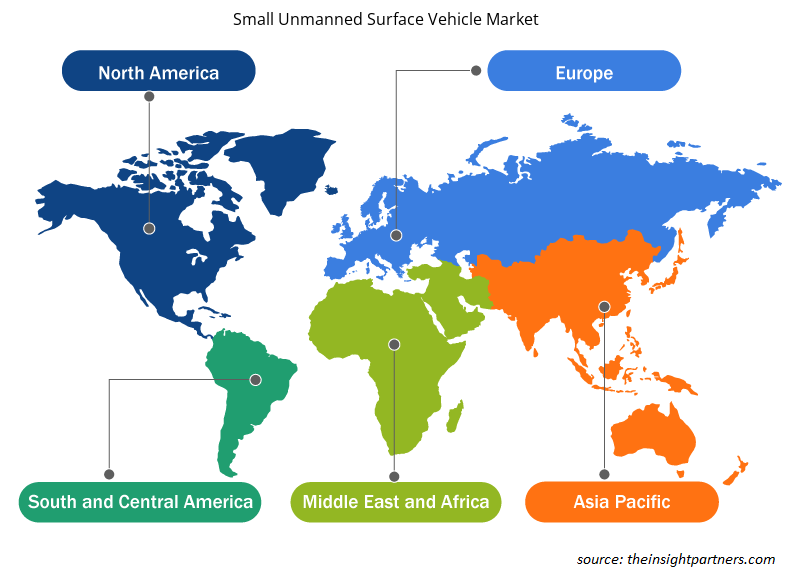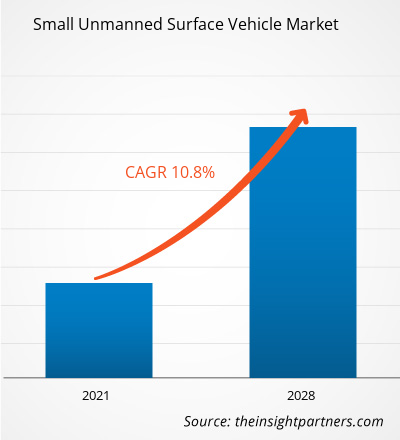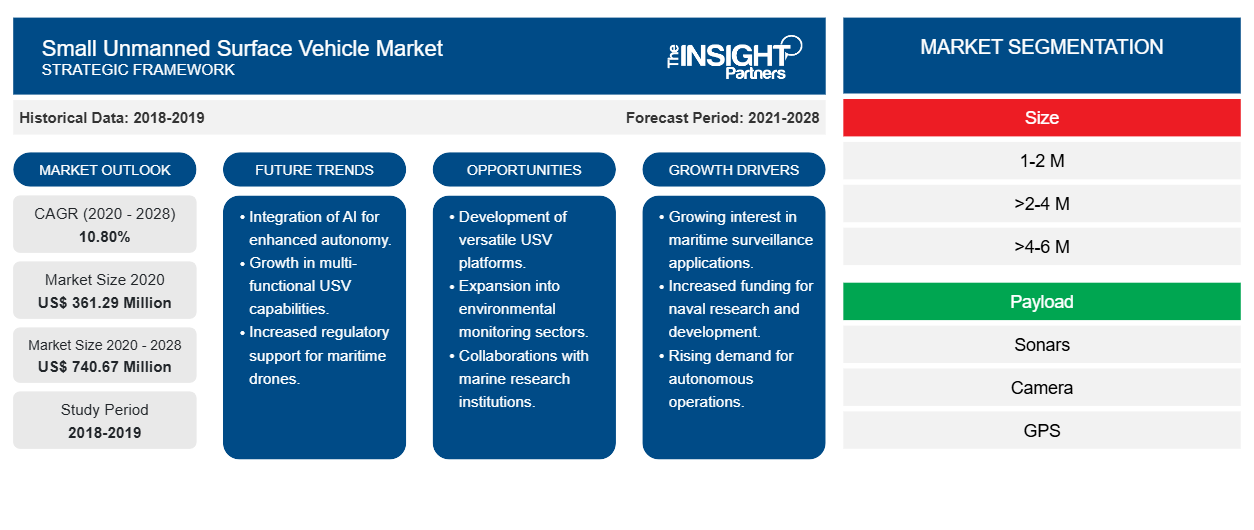[Informe de investigación] Se espera que el mercado de vehículos de superficie no tripulados pequeños crezca de US$ 361,29 millones en 2021 a US$ 740,67 millones en 2028; se estima que crecerá a una CAGR del 10,80% entre 2021 y 2028.
Factores importantes como el aumento de la demanda de mapeo de datos oceánicos con monitoreo de la calidad del agua y el aumento de la demanda de patrullaje de aguas costeras y operaciones de guerra antisubmarina impulsan el crecimiento del mercado de vehículos de superficie pequeños no tripulados . Además, las inversiones continuas en tecnologías de exploración marina no tripulada generarían enormes oportunidades para los vendedores del mercado durante el período de pronóstico. Con el crecimiento de los desarrollos costeros, el dominio marítimo se está congestionando cada vez más, impulsado por actores estatales y no estatales que utilizan el mar para diversas actividades. Las garantías tienen un gran énfasis en la vigilancia y protección marítimas. Por lo tanto, los activos modernos, como los vehículos no tripulados, se despliegan para reducir los riesgos de vida humana y mitigar los contactos enemigos al trasladarse a otros dominios. Además, la creciente aplicación de la conectividad digital actúa como un factor importante en el crecimiento de los sistemas oceánicos no tripulados. Como la conectividad juega un papel primordial para las modernas fuerzas marítimas y submarinas en red, los sectores de defensa en los principales países están invirtiendo sustancialmente en el desarrollo de sensores submarinos conectados, plataformas sumergidas y activos de superficie con sistemas aéreos y activos espaciales, así como en operaciones cibernéticas. Se prevé que este factor impulse la expansión de las operaciones de activos no tripulados para contrarrestar cualquier amenaza adversaria potencial. Por lo tanto, se espera que las inversiones continuas en el desarrollo de tecnologías de exploración en aguas profundas brinden numerosas oportunidades rentables para los actores del mercado de vehículos submarinos no tripulados y vehículos de superficie no tripulados en los próximos años.
Personalice este informe según sus necesidades
Obtendrá personalización en cualquier informe, sin cargo, incluidas partes de este informe o análisis a nivel de país, paquete de datos de Excel, así como también grandes ofertas y descuentos para empresas emergentes y universidades.
- Obtenga las principales tendencias clave del mercado de este informe.Esta muestra GRATUITA incluirá análisis de datos, desde tendencias del mercado hasta estimaciones y pronósticos.
Impacto de la pandemia de COVID-19 en el mercado de vehículos terrestres no tripulados de pequeño tamaño
La pandemia de COVID-19 afectó a casi todas las industrias del mundo en el año fiscal 2020 debido a las medidas de confinamiento impuestas por varios países. Las restricciones interrumpieron la cadena de suministro de diferentes industrias y generaron una brecha entre la oferta y la demanda en las industrias. Debido a la pandemia, la reducción de las inversiones en tecnologías de automatización afectó negativamente al mercado de vehículos de superficie no tripulados pequeños en América del Norte en 2020. Sin embargo, se espera que el mercado recupere su crecimiento en el segundo trimestre de 2022, según un estudio de investigación.
En términos de operaciones hidrográficas, la pandemia de COVID-19 no ha afectado mucho a la adopción de tecnologías de automatización. Las operaciones de la industria marina se suspendieron durante los dos primeros trimestres de 2020, lo que afectó a la demanda de vehículos de superficie no tripulados en toda la región de América del Norte. Además, la demanda de sistemas no tripulados ha aumentado en los últimos años, lo que se ha convertido en una tendencia en las operaciones de la industria marina. Por ejemplo, el sector de defensa se ha convertido en uno de los mercados de mayor crecimiento para los sistemas no tripulados en América del Norte, específicamente en los EE. UU., debido a las crecientes inversiones en la adopción de vehículos autónomos no tripulados en toda la industria de defensa. Este factor ha impulsado el crecimiento del mercado de vehículos de superficie no tripulados pequeños en 2020.
Perspectivas de mercado: mercado de vehículos terrestres no tripulados de pequeño tamaño
Aumento de la demanda de mapeo de datos oceánicos y monitoreo de la calidad del agua
Un mapa preciso del fondo del océano es necesario para la navegación, el transporte, la pesca, las telecomunicaciones y la energía marina, y para comprender las propiedades físicas y las corrientes del océano relacionadas con el clima y el tiempo. El vehículo autónomo de largo alcance puede mapear el océano de una manera respetuosa con el medio ambiente. Además, un mapeo de datos oceánicos con un vehículo autónomo requiere menos mano de obra y costos que el mapeo tradicional desde un barco. Las organizaciones gubernamentales y las agencias privadas están invirtiendo significativamente en la fabricación y el desarrollo de pequeños vehículos de superficie no tripulados avanzados y eficientes para el mapeo de datos oceánicos. Por lo tanto, existe una creciente demanda mundial de pequeños USV. Estos vehículos se utilizan en diversas aplicaciones, como la recopilación y el mapeo de datos oceánicos, el monitoreo de la calidad del agua y la protección de aguas poco profundas y puertos.
La contaminación del agua es un problema grave, especialmente en los países en desarrollo. Por ello, el control de la calidad del agua se ha vuelto crucial para su protección. Con el rápido desarrollo de la industria y la urbanización, las aguas residuales industriales y sanitarias han afectado gravemente a las fuentes de agua dulce en todo el mundo, especialmente en los países en desarrollo. Esto ha influido significativamente en las condiciones de vida de los seres humanos. Para controlar la calidad del agua se utilizan nuevas tecnologías de medición, como las mediciones a bordo de barcos y los sistemas IoT.
Perspectivas basadas en el tamaño
Según el tamaño, el mercado de vehículos de superficie no tripulados pequeños se segmenta en 1-2 M, >2-4 M y >4-6 M. El segmento de 1-2 M tuvo la mayor participación de mercado en 2021.
Los actores que operan en el mercado de pequeños vehículos de superficie no tripulados se centran principalmente en el desarrollo de productos avanzados y eficientes.
- En mayo de 2021, Seabed anunció un nuevo concesionario con Waterlinked. Waterlinked es conocida por tener el DVL más pequeño del mundo y sus módems submarinos y GPS.
- En enero de 2021, Seabed anunció un nuevo acuerdo con Hemisphere y se convirtió en el distribuidor oficial de Hemisphere en el Benelux. Hemisphere GNSS se ha convertido en un líder en el mercado de posicionamiento y rumbo por satélite de alto rendimiento con una sólida base tecnológica.
Perspectivas regionales del mercado de vehículos terrestres no tripulados de pequeño tamaño
Los analistas de Insight Partners explicaron en detalle las tendencias y los factores regionales que influyen en el mercado de vehículos de superficie no tripulados pequeños durante el período de pronóstico. Esta sección también analiza los segmentos y la geografía del mercado de vehículos de superficie no tripulados pequeños en América del Norte, Europa, Asia Pacífico, Oriente Medio y África, y América del Sur y Central.

- Obtenga datos regionales específicos para el mercado de vehículos de superficie no tripulados pequeños
Alcance del informe sobre el mercado de vehículos terrestres no tripulados de pequeño tamaño
| Atributo del informe | Detalles |
|---|---|
| Tamaño del mercado en 2020 | US$ 361,29 millones |
| Tamaño del mercado en 2028 | US$ 740,67 millones |
| Tasa de crecimiento anual compuesta (CAGR) global (2020-2028) | 10,80% |
| Datos históricos | 2018-2019 |
| Período de pronóstico | 2021-2028 |
| Segmentos cubiertos | Por tamaño
|
| Regiones y países cubiertos | América del norte
|
| Líderes del mercado y perfiles de empresas clave |
|
Densidad de actores del mercado: comprensión de su impacto en la dinámica empresarial
El mercado de vehículos terrestres no tripulados pequeños está creciendo rápidamente, impulsado por la creciente demanda de los usuarios finales debido a factores como la evolución de las preferencias de los consumidores, los avances tecnológicos y una mayor conciencia de los beneficios del producto. A medida que aumenta la demanda, las empresas amplían sus ofertas, innovan para satisfacer las necesidades de los consumidores y aprovechan las tendencias emergentes, lo que impulsa aún más el crecimiento del mercado.
La densidad de actores del mercado se refiere a la distribución de las empresas o firmas que operan dentro de un mercado o industria en particular. Indica cuántos competidores (actores del mercado) están presentes en un espacio de mercado determinado en relación con su tamaño o valor total de mercado.
Las principales empresas que operan en el mercado de vehículos de superficie no tripulados pequeños son:
- HIDRONALIX
- Instrumentos de datos Aanderaa AS
- AutoNaut Ltd.
- Energía marina ecológica
- Robótica líquida, inc.
Descargo de responsabilidad : Las empresas enumeradas anteriormente no están clasificadas en ningún orden particular.

- Obtenga una descripción general de los principales actores clave del mercado de vehículos de superficie no tripulados pequeños
El mercado de terminación de pozos se ha segmentado de la siguiente manera:
Mercado de vehículos terrestres no tripulados de pequeño tamaño: por tamaño
- 1–2 millones
- >2–4 millones
- >4–6 millones
Mercado de vehículos terrestres no tripulados de pequeño tamaño (por carga útil)
- Sonar
- Cámara
- GPS
- Comunicaciones por satélite
- Otros
Mercado de vehículos terrestres no tripulados de pequeño tamaño: por aplicación
- Defensa
- Investigación científica
- Gestión de desastres
- Hidrografía
- Otros
Mercado de vehículos terrestres no tripulados de pequeño tamaño (por geografía)
- América del norte
- A NOSOTROS
- Canadá
- México
- Europa
- Alemania
- Francia
- Italia
- Reino Unido
- Rusia
- Resto de Europa
- Asia Pacífico (APAC)
- Porcelana
- India
- Japón
- Corea del Sur
- Tailandia
- Resto de APAC
- Oriente Medio y África
- Sudáfrica
- Resto de MEA
- Sudamerica
- Brasil
- Argentina
- Resto de SAM
Mercado de vehículos terrestres no tripulados de pequeño tamaño: perfiles de empresas
- HIDRONALIX
- Instrumentos de datos Aanderaa AS
- AutoNaut Ltd
- Energía marina ecológica
- Robótica líquida, Inc.
- Grupo OceanAlpha Ltd.
- Fondo marino BV
- Corporación SeaRobotics
- Sirehna
- Grupo QinetiQ plc
- Análisis histórico (2 años), año base, pronóstico (7 años) con CAGR
- Análisis PEST y FODA
- Tamaño del mercado, valor/volumen: global, regional y nacional
- Industria y panorama competitivo
- Conjunto de datos de Excel
Informes recientes
Informes relacionados
Testimonios
Razón para comprar
- Toma de decisiones informada
- Comprensión de la dinámica del mercado
- Análisis competitivo
- Información sobre clientes
- Pronósticos del mercado
- Mitigación de riesgos
- Planificación estratégica
- Justificación de la inversión
- Identificación de mercados emergentes
- Mejora de las estrategias de marketing
- Impulso de la eficiencia operativa
- Alineación con las tendencias regulatorias





















 Obtenga una muestra gratuita para - Mercado de vehículos de superficie no tripulados pequeños
Obtenga una muestra gratuita para - Mercado de vehículos de superficie no tripulados pequeños